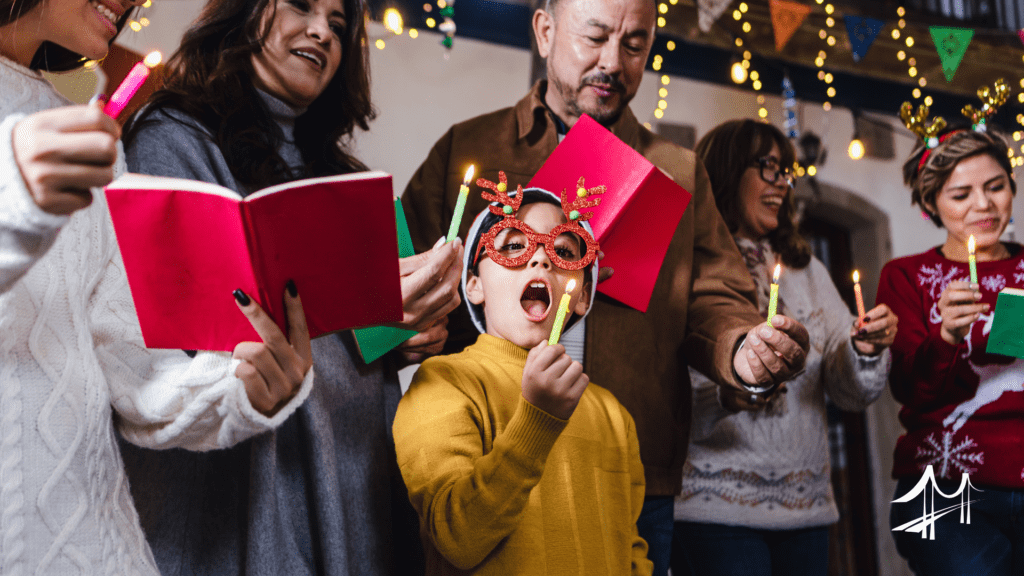For many, the holiday season—spanning the five festive weeks from Thanksgiving to New Year’s Day—is filled with cherished traditions: office parties, gatherings with friends, family feasts, the excitement of opening presents, and a grand New Year’s Eve celebration. You might have long-standing traditions around who hosts each event, the foods served, how gifts are opened, and even favorite family games. Often, in all the excitement, it’s easy to overlook that, for Christians, this season is about celebrating the birth of Christ. In Hispanic families, this significance often plays a central role in the holiday festivities.
Latino Holiday Season Traditions
Celebrations vary widely across Spanish-speaking countries, and many of these beloved traditions have found a home in the U.S. Latino holiday celebrations are often rich in both cultural and religious elements. A common sight in the home is the Arbolito de Navidad (Christmas Tree) alongside a Pesebre (Nativity Scene) where the baby Jesus figurine isn’t added until December 25th. Catholic masses and special novenas or prayers are also part of the season. Here are some other unique Latino holiday traditions:
Las Posadas (The Inns) –
This Mexican heritage celebration takes place over the nine days leading up to Christmas, from December 16-24. Each night, a procession of children, dressed as Mary, Joseph, shepherds, and angels, goes door to door, symbolically seeking shelter before finally arriving at a local church for Mass. Afterward, children break open star-shaped piñatas and enjoy treats. On Christmas Eve, the celebration reaches its peak with food like romeritos (baked shrimp), bacalao (dried cod), sweet buñuelos (fried dough), and Christmas rompope (a twist on eggnog), along with music, games, and sometimes fireworks.

Nochebuena (Holy Night/Christmas Eve) –
“‘Twas the night before Christmas and all through the casa….” While this Spanglish parody of the classic poem is a fun take on holiday traditions, Nochebuena holds an even deeper cultural significance for many Hispanics, often rivaling Christmas Day. Celebrations vary by country, with families spending the afternoon enjoying food, drinks, dancing, and games. After midnight, many attend the Misa de Gallo (Mass of the Rooster) and then return home to continue the festivities. Foods include those popular during Las Posadas, as well as pork, rice, tamales, and tacos, accompanied by lively music and dancing. Nochebuena is also a time for exchanging gifts, meaning many Latino families open presents a day earlier than others!
El Año Viejo (The Old Year) –
While you may be used to “New Year’s Eve” parties, Latinos also celebrate by bidding farewell to the Old Year. Some families make life-sized dolls to represent the hardships or negative events of the past year and burn them at midnight to symbolize a fresh start. Another popular tradition, rooted in Spain, is “The Twelve Grapes.” At the stroke of midnight, one grape is eaten for each toll of the clock, symbolizing a wish for each month of the coming year. To increase your luck, try wearing yellow or red underwear, and carry a suitcase around the block or place it by the door to encourage travel in the New Year.
El Año Nuevo (New Year’s)
In the U.S., January 1st typically marks the end of the holiday season. But leave it to Latinos to extend the festivities for another week or more, with more gifts and delicious food still to come!
Día de Los Tres Reyes Magos (Three Kings’ Day) –
Known as Epiphany, January 6th celebrates the end of the 12-day journey of the Wise Men, who brought gifts to Jesus. On January 5th, children leave their shoes by the bed with grass and water for the camels. In many homes, the Nativity Scene is taken down on this day. A festive food, Rosca de Reyes (Kings’ Cake), is served—a round sweet bread decorated with dried fruits symbolizing jewels in a crown, and a tiny baby Jesus figurine hidden inside. Whoever finds the figurine must host a celebration on Día de la Candelaria (Candlemas Day) on February 2nd.
Whew! That’s a lot of celebrating! With the holiday season stretching across weeks, there are countless opportunities to gather with loved ones—whether it’s with family and close friends nearby, or reaching out to relatives and friends across states or even countries in Central America, South America, and the Caribbean.
Another wonderful way to celebrate the season is by supporting local small businesses and artisans. Shopping locally or buying from Latino-owned businesses not only brings unique gifts to your loved ones but also uplifts the community. Get the whole family involved by using a name exchange app and supporting local vendors for a meaningful holiday gift exchange.
For those who celebrate, it’s essential to embrace inclusive practices, especially in the workplace, to recognize cultural and religious holidays. Whether as a manager, a coworker, or a retailer, being culturally aware can foster goodwill and even boost sales—particularly by appealing to Hispanic consumers through Día de Los Tres Reyes Magos, which extends holiday sales for nearly two more weeks.
So, plan a call on Nochebuena or Día de Los Tres Reyes Magos, exchange gifts, enjoy favorite dishes, and connect with family and friends across distances. On behalf of the Cool family, we wish you and yours a safe and joyous Feliz Navidad and a Próspero Año Nuevo (Happy New Year)!
Image source:
Posada, Mexican family Singing carols in Christmas party in Mexico Latin people by Marcos Elihu Castillo Ramirez from Getty Images


